Implementation of digital workflow at Aarhus University Hospital Department of Radiotherapy
Introduction
In April 2021, the Department of Radiotherapy at Aarhus University Hospital (Denmark) transitioned from paper-based workflow to a fully digital format. The objective was to optimise efficiency in all parts of the clinic, from booking, scanning and dose planning to the actual treatment, while minimising the risk of accidents and mistakes.
This article is focused on the part of the process that is of greatest relevance for the radiotherapy technologists (RTTs) – i.e., the transition from having all treatment-related information on paper to having them solely in a digital format.
The department runs nine Varian TrueBeam linacs (VTBL) at the primary site and two additional Varian Clinac linacs (VCL) at a separate site in the city of Herning (HEV). These machines are operated by about 80 RTTs in total. The development and subsequent implementation of the digital workflow (DW) was handled by a core-team that comprised two RTTs and two medical physicists. This team was supported by a cross-disciplinary team of heads of departments.
Digital workflows
The primary focus was to create digital versions of the two original paper documents that contained patient positioning and treatment information, respectively. The digital versions were required to resemble the paper versions as closely as possible, with adjustments that were deemed to increase clarity. The information presented in these documents was entered and, if necessary, edited in customised questionnaires in the module Encounters in the ARIA software suite that is supplied by Varian Inc.
In these digital copies, parameters directly related to specific fixation equipment are displayed on an image of the equipment rather than through the somewhat obscure, tabulated form that was used previously. Treatment information such as imaging modality for image-guided radiotherapy or match strategy has been rearranged into a more logical sequence. Additionally, the digital format facilitates the suppression of information that is irrelevant to a specific patient when the final documents are generated. The final versions are visible on dedicated monitors in both the control and treatment rooms. Use of the digital format ensures that the documents contain only current information if adjustments have been made during the course of treatment (Images 1-4).
Implementation
The training of the RTTs in the new DW was adapted to accommodate different methods of learning. Specifically, the training was based on the following four learning methods:
- visual (learning by seeing);
- auditory (learning by listening);
- read/write (learning by reading and/or taking notes); and
- kinaesthetic (learning by performing physical tasks).
In general, a person uses more than one of the abovementioned methods (1). Consequently, the teaching material utilised a combination of these methods to facilitate optimal training, albeit with primary emphasis on the visual, auditory and kinaesthetic methods.
As end-users, the RTTs were informed of key aspects of the implementation as early as possible to ensure the best possible level of preparation. Pre-production versions of the electronic documents were presented to the RTTs at an early stage to gain feedback on content and layout as well as gradually to familiarise the group with the digital mode of working. This had the added benefit of easing any concerns about the project as a whole. The RTTs had tangible evidence that the documents contained only relevant information, were not cluttered and showed layouts that closely resembled those of the well-known paper documents.
Two months prior to implementation, clinical tests were initiated by the core group of RTTs with representatives from both sites. Over a period of three weeks, a wide range of diagnoses were treated using the pre-production DW to identify any errors and mitigate as many of them as was possible. The process was very successful, to the point at which it was possible to include the rest of the RTT group and to ensure that all had participated in at least one treatment. This made subsequent teaching much more relatable and concrete to the group of RTTs who had not been involved in the development phase.
One month before roll-out, the RTTs received a three-hour tuition session. The oral presentation combined visual (especially in the form of screen shots from various ARIA modules), auditory and read/write styles of learning. ARIA modules that were previously unknown to the RTTs, such as UserHome and Encounters, were introduced as well. The latter was especially important, since it formed the backbone of the DW. The teaching material was made available to all so that viewers could revisit it. It was clear from the questions that were asked during the teaching session that the long-term information strategy had given the RTTs a high level of prior knowledge.
In mid-March 2021, the DW was rolled out at the small HEV site. It was rolled out simultaneously on both VCLs due to the logistical challenges that would have been posed by machine failures had it been on a single VCL only. On the first day, each VCL administrator had support from an RTT and a physicist from the core team. There were very few challenges and minimal delays during the first day of implementation and it was possible to complete a full day’s treatment schedule on both machines.
In mid-April 2021, implementation of the DW started at the main site, two VTBLs at a time with one-week intervals between each set of machines. As in HEV, each treatment RTT team was supported by an RTT from the core team. Apart from the previously mentioned tuition, no additional training had been provided and no “super users” apart from the core group had been appointed. After the first two days, the treatment teams could treat autonomously with only occasional need of assistance. It was imperative that the workflow was fully implemented as soon as possible to regain the normal flexibility across VTBLs and treatment teams in cases of illness and/or technical malfunctions etc.
Throughout the entire process there was special emphasis on the kinaesthetic style of learning in order to make sure that the RTTs experienced the ergonomics of the new workflows, both in terms of working position and use of multiple workstations. Of course, all modes of learning were involved during the actual roll-out and the real-time assistance from the core group RTTs when situations arose that required expert assistance.
Acknowledgements
The presented work is the result of a long-running and very rewarding collaboration within the core team. RTTs Margit Holst Andersen and Hanne Rinder, and medical physicists Maj-Britt Linaa and Rune Hansen, are gratefully acknowledged for their invaluable contributions.
References:
(1) Prithishkumar I J, Michael S A. Understanding your student: Using the VARK model. J postgrad Med 2014;60:183-6.
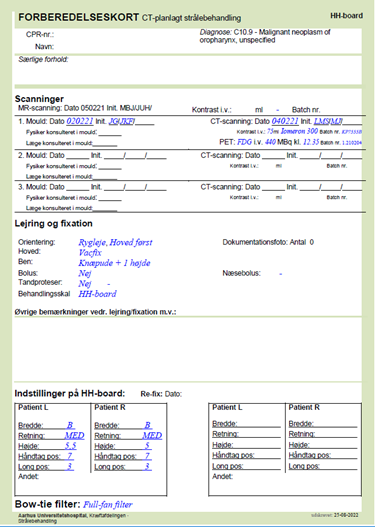
Paper version of a positioning document that was used before DW (text in Danish).
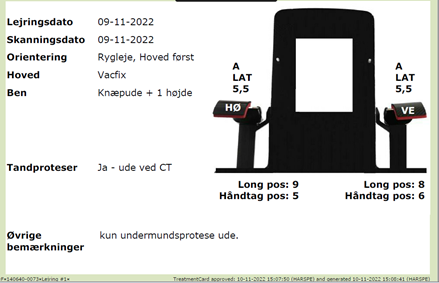
Digital version of a positioning document used after DW (text in Danish). The digital version is less cluttered than the paper version and presents relevant information with greater clarity.

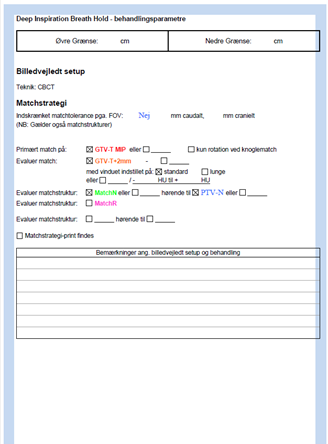
Paper version of a treatment document used before DW (text in Danish).
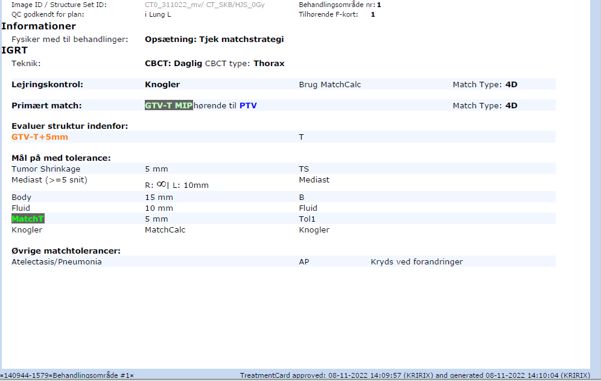
Digital version of a treatment document used after DW (text in Danish). As with the positioning documents, the digital version is less cluttered than the paper version and presents relevant information with greater clarity.
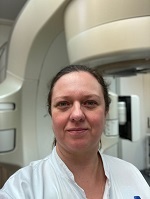
Karina Quist Erichstrup
RTT, Aarhus University Hospital
Aarhus, Denmark
karieric@rm.dk